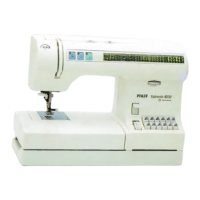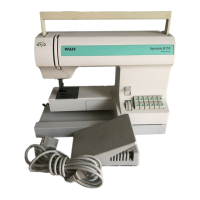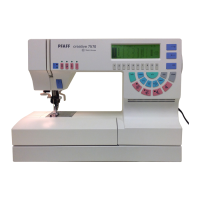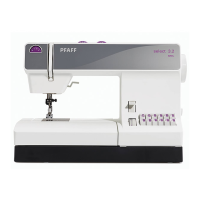Patchwork
quilt
Patching and
quilting
are traditional handicraft
techniques which were originally used by
North American pioneer women
to
make use
of
leftover fabric. Over
the
years it has develo-
ped into a creative
hobby
.
Patchwork quilts used
to
be sewn exclusively
by hand. Nowadays, however, you have the
possibility
to
make your creative ideas a reality
in
a much shorter time.
A patchwork
quilt
always consists
of
three lay-
ers
of
fabric:
A
number
of
geometric pieces
of
fabric are
combined
in
different variations
to
create a
patchwork
which
forms
the
top
of
the
quilt.
This is then basted
to
a
fleece
layer
and then
sewn
onto
the
back
of
the
quilt
which usually
consists
of
one piece
of
fabric. The entire
quilt
is
often bound by
this
bottom
layer.
The
quilt
and
patchwork
foot
(special acces-
sories -
see
page
81)
is particulary helpful
for
sewing
patchwork
and quilting. The distance
of
the needle
to
the
outer edge
of
the
foot is
e 1/ 4 inch (6.3 mm), and 1/8 inch (3.15 mm)
to
a
the
inner edge.
'""
70
And here's
how
i
t'
s done:
- Using your own
or
commercially available
templates,
cut
the
pieces you need
for
your
patchwork
. The templates should include a
seam
allowance
of
1/4 inch (6.3 mm).
- Spread these pieces out
in
front
of
you in
accordance
with
the
pattern and
form
small
squares
which
you can then
put
together.
These squares
will
then be sewn
together
and
will
form
the
top
ply
of
the
quilt
.
- The seam
allowances are
not
serged when
quilting, but instead are
to
be smoothed
down
, never ironed!
- Baste
the
finished
top
ply
of
the
quilt
onto
the
fleece insert and
the
bottom
quilt
layer.
- Traditionally, these three fabric layers are
sewn
together
with
small stitches by hand.
This procedure is faster and more practical
with
a sewing machine, e.
g.
with
the
pro-
gram
FG
Stretch
or
L Stretch. Always sew
approximately 3
mm
next
to
the
seam.
Embroidery stitches are particularly suitable
for
un
i-colored materials. Here you should
use
the
decorative stitch
foot
No.1. You can
then continue
to
sew your quilt, making it
into a
cushion, a wall hanging
or
a bed-
spread.
